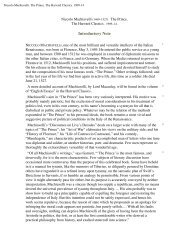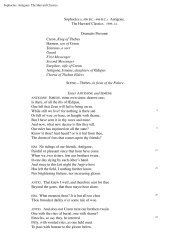Notre Dame de Paris - Bartleby.com
Notre Dame de Paris - Bartleby.com
Notre Dame de Paris - Bartleby.com
Create successful ePaper yourself
Turn your PDF publications into a flip-book with our unique Google optimized e-Paper software.
he came to visit <strong>Paris</strong>, and the lions, who had a palace for themselves within the royal palace. And we<br />
must observe here that a prince’s lodging <strong>com</strong>prised in those days not less than eleven apartments, from<br />
the state chamber to the oratory, besi<strong>de</strong>s all the galleries, the baths, the “sweating-rooms,” and other<br />
“superfluous places” with which each suite of apartments was provi<strong>de</strong>d—not to mention the gar<strong>de</strong>ns<br />
specially allotted to each guest of the King, nor the kitchens, store-rooms, pantries, and general<br />
refectories of the household; the inner court-yards in which were situated twenty-two general offices,<br />
from the bakehouse to the royal cellarage; the grounds for every sort and <strong>de</strong>scription of game—mall,<br />
tennis, tilting at the ring, etc.; aviaries, fish-ponds, menageries, stables, cattle-sheds, libraries, armouries,<br />
and foundries. Such was, at that day, a King’s palace—a Louvre, an Hôtel Saint-Pol—a city within a<br />
city.<br />
From the tower on which we have taken up our stand, one obtained of the Hôtel Saint-Pol, though<br />
half-hid<strong>de</strong>n by the four great mansions we spoke of, a very consi<strong>de</strong>rable and won<strong>de</strong>rful view. You could<br />
clearly distinguish in it, though skilfully wel<strong>de</strong>d to the main building by windowed and pillared galleries,<br />
the three mansions which Charles V had absorbed into his palace: the Hôtel du Petit-Muce with the<br />
fretted parapet that gracefully bor<strong>de</strong>red its roof; the Hôtel of the Abbot of Saint-Maur, having all the<br />
appearance of a fortress, with its massive tower, its machicolations, loopholes, iron bulwarks, and over<br />
the great Saxon gate, between the two grooves for the drawbridge, the escutcheon of the Abbot; the Hôtel<br />
of the Comte d’Etampes, of which the keep, ruined at its summit, was arched and notched like a<br />
cock’s-<strong>com</strong>b; here and there, three or four ancient oaks grouped together in one great bushy clump; a<br />
glimpse of swans floating on clear pools, all flecked with light and shadow; picturesque corners of<br />
innumerable court-yards; the Lion house, with its low Gothic arches on short Roman pillars, its iron bars<br />
and continuous roaring; cutting right through this picture the scaly spire of the Ave-Maria Chapel; on the<br />
left, the Mansion of the Provost of <strong>Paris</strong>, flanked by four <strong>de</strong>licately perforated turrets; and, in the centre<br />
of it all, the Hôtel Saint-Pol itself, with its multiplicity of faça<strong>de</strong>s, its successive enrichments since the<br />
time of Charles V, the heterogeneous excrescences with which the fancy of the architects had loa<strong>de</strong>d it<br />
during two centuries, with all the roofs of its chapels, all its gables, its galleries, a thousand<br />
weather-cocks turning to the four winds of heaven, and its two lofty, contiguous towers with conical<br />
roofs surroun<strong>de</strong>d by battlements at the base, looking like peaked hats with the brim turned up.<br />
Continuing to mount the steps of this amphitheatre of palaces, rising tier upon tier in the distance,<br />
having crossed the <strong>de</strong>ep fissure in the roofs of the Town which marked the course of the Rue<br />
Saint-Antoine, the eye travelled on to the Logis d’Angoulême, a vast structure of several periods, parts of<br />
which were glaringly new and white, blending with the rest about as well as a crimson patch on a blue<br />
doublet. Nevertheless, the peculiarly sharp and high-pitched roof of the mo<strong>de</strong>rn palace—bristling with<br />
sculptured gargoyles, and covered with sheets of lead, over which ran sparkling incrustations of gil<strong>de</strong>d<br />
copper in a thousand fantastic arabesques—this curiously damascened roof rose gracefully out of the<br />
brown ruins of the ancient edifice, whose massive old towers, bulging cask-like with age, sinking into<br />
themselves with <strong>de</strong>crepitu<strong>de</strong>, and rent from top to bottom, looked like great unbuttoned waistcoats.<br />
Behind rose the forest of spires of the Palais <strong>de</strong>s Tournelles. No show-place in the world—not even<br />
Chambord or the Alhambra—could afford a more magical, more ethereal, more enchanting spectacle<br />
than this grove of spires, bell-towers, chimneys, weather-cocks, spiral stair-cases; of airy lantern towers<br />
that seemed to have been worked with a chisel; of pavilions; of spindle-shaped turrets, all diverse in<br />
shape, height, and position. It might have been a gigantic chess-board in stone.<br />
That sheaf of enormous black towers to the right of the inky Tournelles, pressing one against the other,<br />
and bound together, as it were, by a circular moat; that donjon-keep, pierced far more numerously with










